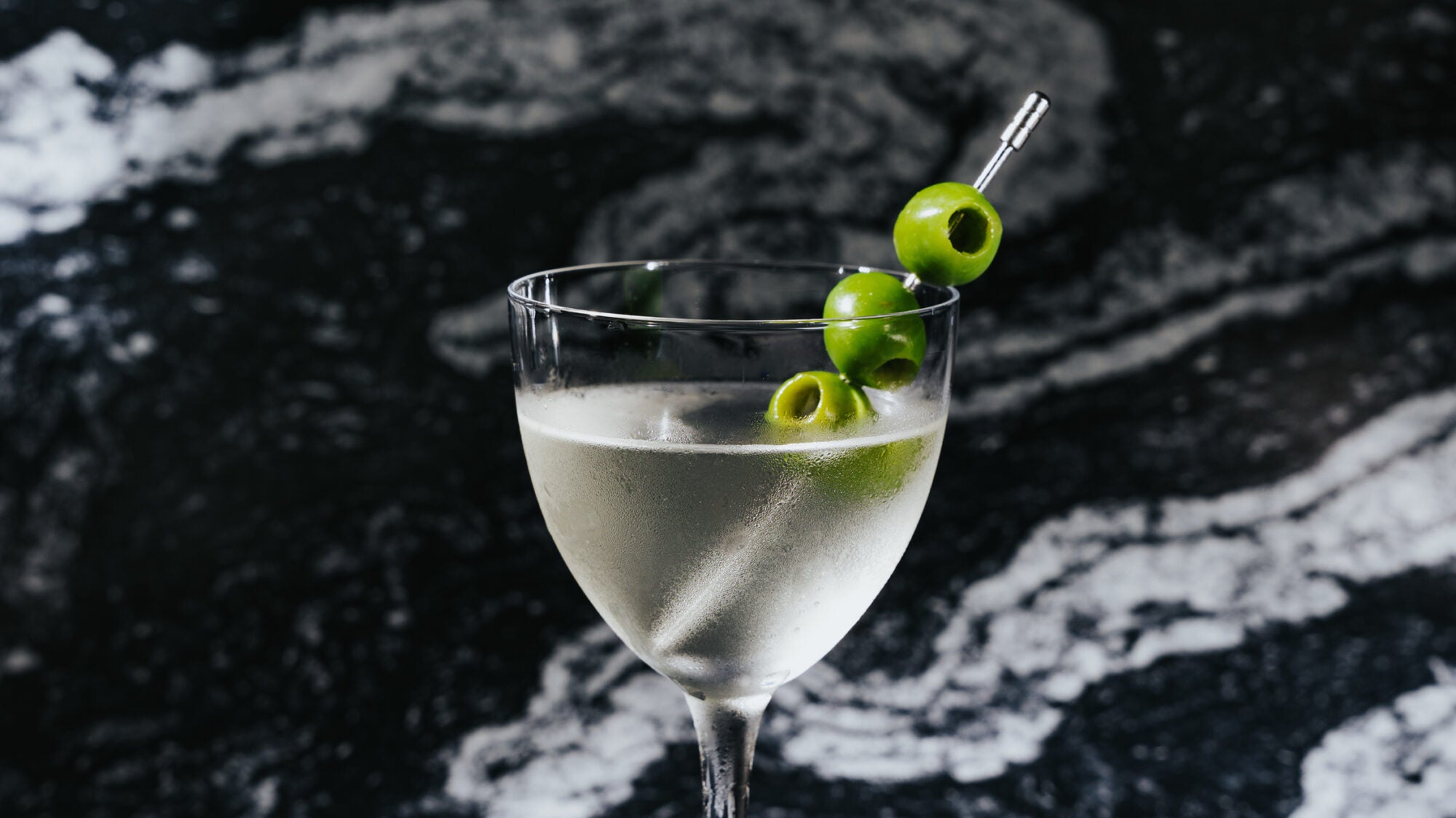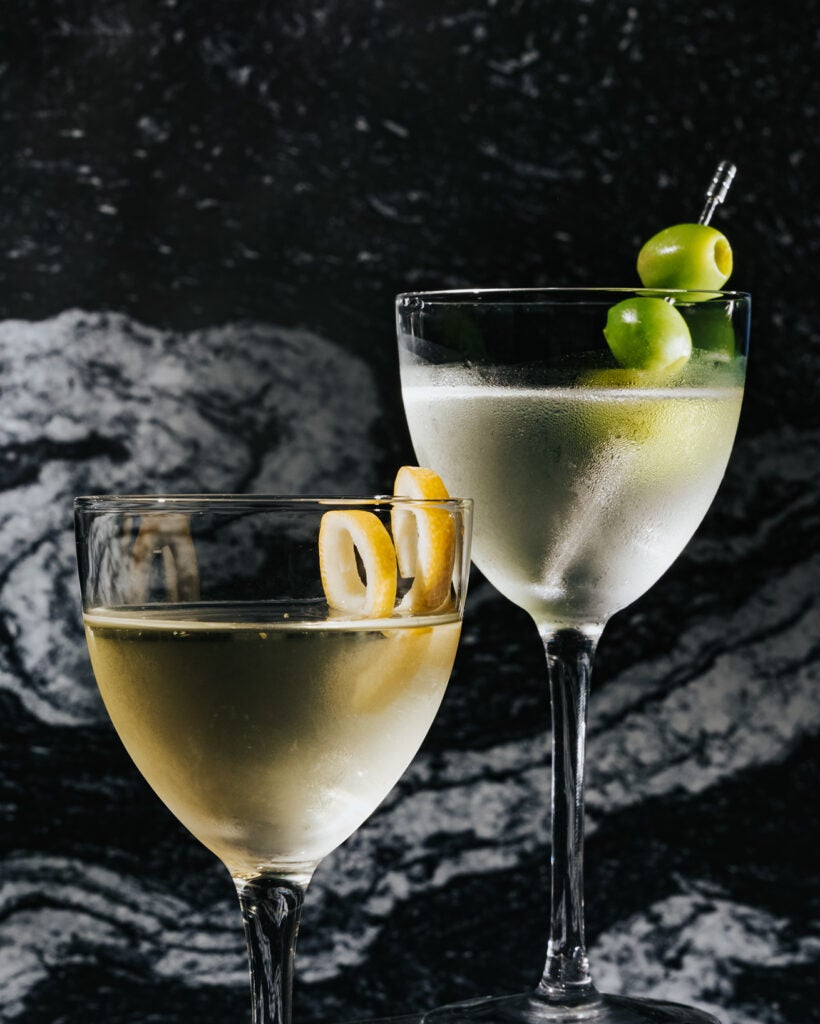
There’s no hiding the alcohol flavor in a martini. We accept this challenge.
A martini is an alcohol lover’s drink. It contains literally nothing else. And every martini lover has a specific order, like a secret handshake with the bartender. Some like it with English dry gin, and some like it with a smooth French vodka. Gin is traditional and what I prefer, but last winter, I briefly flirted with ordering vodka martinis. I went back to gin when I realized I could drink three of the vodka iteration quite quickly. Unlike a gimlet or a negroni, there’s no blending and masking of the alcohol flavor here. As Jonah Bergman, owner of Bait Shop bar in Seattle, says, “It’s just two shots of gin chilled in a glass.”
With the martini, the alcohol is the drink. Bergman adds, “From a historical perspective, the martini is a drink that was originally half vermouth and half gin because gin was so disgusting and gnarly to drink that you’d have to cut it.” Over time, the drink has evolved into what Bergman calls “a race to dryness”: finding the perfect vermouth-to-gin ratio for balance. There may be a hint of lemon rind or olive juice to give it some flavor, but there’s no masking the fact that you are drinking a large glass of straight alcohol, a substance that science tells us is basically poison, or as the World Health Organization notes: “a toxic, psychoactive, and dependence-producing substance” with “no level of consumption safe for our health.” Yikes.
This idea of alcohol as poison is most of why I decided to dramatically cut down my alcohol intake earlier this year. After a particularly overindulgent weekend of a few burgers and many martinis, I woke up Monday feeling like a waterlogged corpse. It took me days to recover, and I knew it was time to make a change. I quietly decided to just stop drinking for a while.
Unbeknownst to me (a social drinker with no previous need for nonalcoholic beverages), the nondrinking world had been very busy these past few years. Eliminating alcohol was so much easier than I thought. The nonalcoholic or NA beer scene has exploded. Complex microbrews taste similar to the real thing; Athletic’s delicious NA beers are widely available in major cities. St. Agrestis makes a delicious NA cocktail called a Phony Negroni. At a certain kind of cocktail bar, you can have something delicious that looks just like your friend’s smoked old-fashioned and not feel like a downer.
But there’s no hiding the alcohol flavor in a martini—it’s the main event. While complex, fruity creations may be a fair substitute for a cocktail and cold NA beers go down easy, I deeply mourned the loss of a slightly dirty gin martini with olives. My new NA status, bumping up against my love of the martini, sent me on a quest to see what this new world of NA bar orders had to offer—and whether I could create a version for my home bar. Let’s start with the main character. Most NA gins describe themselves as “floral” or “herbal,” which is fine for a gin and tonic but will very quickly ruin a martini. I didn’t try every nonalcoholic gin on the market, but I did try more than a dozen. Nearly all of them were too watery or botanical to make a satisfactory martini.
Initially I was distraught, but a breakthrough came when I visited Spirited Away, “America’s first booze-free bottle shop,” in Lower Manhattan. The tall shelves stacked with gorgeous bottles and cans of nonalcoholic spirits, wines, elixirs, mixers, and beers are indicative of how the NA market has exploded. The helpful shopkeeper heard my plea and said, “ISH, that’s the one.” She was right. So many of the imitation gins I tried focused too much on juniper botanicals while missing that bracing bite of alcohol. ISH’s London Botanical Spirit accomplishes this with the inclusion of all things pepper.
“Spicy” was not a word I would have previously associated with gin, but my husband (a true gin lover) often describes a good gin as “hot,” and that’s what I immediately thought of when I tried ISH for the first time. Both black pepper and capsicum are listed in the short ingredients list to provide a bit of alcoholic bite. “The best NA substitutes are the offerings that provide the same feeling you get from the alcoholic counterparts,” says founder Morten Sørensen, who developed the gin “striving to capture the essence of a classic dry gin.”

To get the flavor right, Sørensen’s product development team went through three iterations. In the latest release, they’ve “intensified the juniper notes and introduced a layer of complexity by adding Sevilla orange zest. We also included 0.6g of sugar per 100ml,” he says, “which brings that subtle ‘gin sweetness’ that was previously missing, rounding out the overall taste experience.”
Once I had my gin, all I needed was my vermouth. Crowdsourcing suggestions from my Instagram followers and bartender friends immediately revealed Roots Divino’s Aperitif Bianco as the obvious choice. It’s made on the Greek island of Lesvos from a mixture of grapes, wormwood, rosemary, gentian, and other Greek herbs. Then the vermouth is dealcoholized through reverse osmosis. It’s delicious mixed with club soda and a sprig of rosemary as well as on its own over ice.
Now onto the dirty business. Not all martini lovers are the same—in fact, one’s martini order is quite divisive. The dirty martini seemed like the easiest to replicate, with its salty, seawater-to-the-nose olive juice flavor. Couldn’t I just freeze some salty olive brine (ideally from a Castelvetrano or Cerignola olive), mix it with any half-decent nonalcoholic spirit, and be done with it? The answer was yes, sort of.
But many of my best and brightest martini-drinking pals are strictly up-with-a-twist kind of people. They turn their nose up at a dirty martini and want the sophistication and flavor of cold gin (or vodka) and a whisper of vermouth. I knew they would not be satisfied if I stopped my quest with a dirty martini. A gin martini up with a twist is an incredibly simple drink that, when done right, is divine, and, when done wrong, tastes very aggressive. If not blended and chilled properly, the herbal juniper of the gin can make the drink feel more like an abrasive shot meant to go down quickly rather than a smooth cocktail that should be savored.
There is no masking the taste of alcohol in an “up-with-a-twist” martini, unlike its dirty friend, and I even considered adding a spritz of rubbing alcohol or nail polish remover just for the aromatic experience. I quickly dismissed that idea as stupid, potentially dangerous, and a violation of the original premise pursuing a version without alcohol. Then I began to think about other very strong-flavored foods like kimchi, sauerkraut, and vinegar. The world of vinegar is vast, but I knew I needed something with a clean taste. I experimented with distilled white vinegar and rice wine vinegar because I thought the yeasty rice flavor might mimic some of the Brett aroma of vermouth.
There’s no hiding the alcohol flavor in a martini—it’s the main event.
But vinegar has such a distinct flavor that it wasn’t right for a drink as pure as a martini—it just came out unpleasant. Eventually I landed on jarred preserved lemons, which have the bitterness that one might associate with a strong drink and whose liquid element (much like olive juice) was the perfect addition to round out the NA vermouth and gin. Mina sells a good jar, or you could make your own if you are patient. Gillian Fitzgerald, owner and operator of Casements bar in San Francisco also recommends batching your NA martinis and putting an entire lemon rind in the bottle to really infuse the flavor.
“Do not water down your NA cocktails,” Fitzgerald warned. The flavors in these NA spirits are already much weaker than their alcoholic counterparts, so melting ice is the enemy. I had great success freezing my batched NA martini and letting it slowly defrost in the fridge right up until the moment of serving (see recipe below). This is the part of the process where we might have the shaken versus stirred debate; however, it doesn’t apply here because the addition of any ice to this NA martini would introduce dreaded diluting water.
So many of the bartenders and martini lovers I spoke with reiterated my initial hypothesis: It’s not about how the martini tastes; it’s about the experience. So when you’re messing around with your NA martini at home, be sure to source delicious olives and use the perfect martini glass (I like this pair from Sophie Lou Jacobsen). Serve with your favorite olives on a metal toothpick, and make sure your liquid is very, very cold.
And the greatest part of drinking cocktails without alcohol? You can drink them anytime. Breakfast martini, anyone?